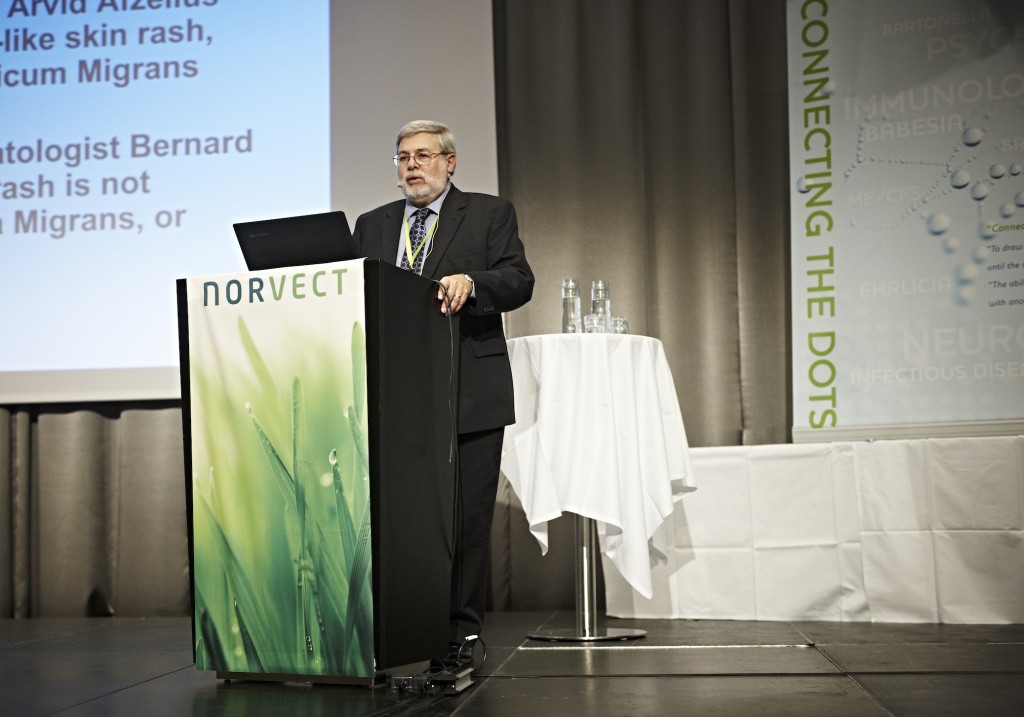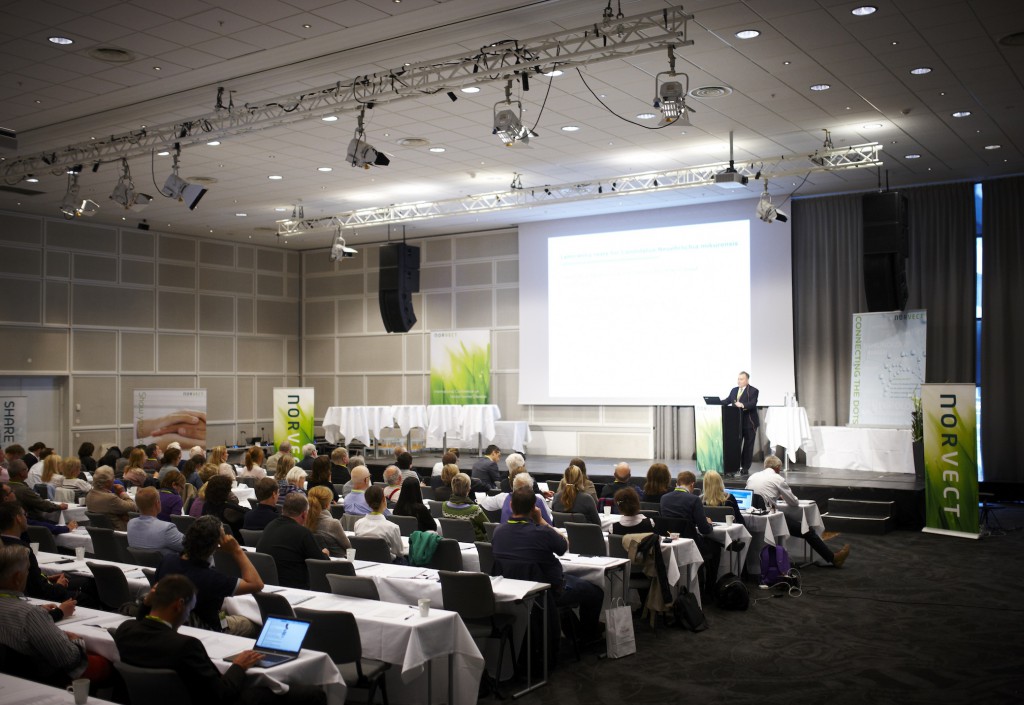According to Prof Kempf, the knowledge of Bartonella is in general low in the medical community. There is a lot of wrong information is circulating.
Bartonella infections are frequent, but general practitioners are not aware of these infectious diseases. According to Prof Kempf, Bartonella infections can be diagnosed and treated easily. However if you don’t know what to look for, you will not find it. You need to look for endocarditis, swollen lymph nodes and other rare manifestations.
According to Kempf, only immunosuppressed patients need treatment. They can be diagnosed using serological essays, which both have weaknesses and strengths. You can find a 6-10% seroprevalance (anti bodies) in the normal population. In forest workers there are 30% that have antibodies against Bartonella.
He states that infections diseases are worldwide and will get even more important in the future.
Dr. Mozayeni talks about Bartonella as one of the major co-infections of Lyme disease. It’s more prevalent than Lyme, as there are many more ways to contract the disease (eg. flees, cats). In a study, that Dr. Breitschwerdt and himself published in The Journal of Emerging Diseases, about 60% of Lyme patients tested positive for Bartonella.
Dr. Mozayeni also talks about the importance of looking at Biofilm when treating Lyme, Bartonella etc as biofilm can harbor many of these microbes and be the cause of many symptoms.
Dr. Armin Schwarzbach talks about the terrible situation for Lyme patients and that they are not getting treated properly. In Germany there is some more openess and doctors are allowed to treat somewhat longer than the guidelines.
He talks about the the bacteria; Borrelia Burgdorferi and its complexity, which again is why this subject is so controversial. Had it been an easy bacteria to diagnose, there would not be so much controvercy. He talks about that the two sides of this controvercy and that they need to come together, as the truth is always in the middle.
Increasingly more ticks studies show that the tick is a dirty needle. There are so many co-infections that can be transfered in one tick bite. This makes the testing system also very complex.
Eikeland is the head The Norwegian National Advisory Unit on Tick-borne Diseases in Kristiansand, Norway.
In the interview, Eikeland talks about Borreliosis and whether it can turn chronic. She does not believe that patients that get Lyme disease and not get well can have a persisting infection. In the interview she claims that there is not enough evidence showing that this is the case in vivo. She also goes on to tell about patients that believe they are ill with Lyme disease, but maybe they have something completely different. She does not advocate long term antibiotics.
She explains that certain Lyme literate doctors and patients live in a different world from the one Eikeland and her colleagues live in. She however claims that it’s a good thing to meet at conferences like NorVect to discuss even though one is of different opinions.
Prof Ying Zhang from John Hopkins Bloomberg School of Public Health explains why Lyme disease is so difficult to treat. Having worked with Tuberculosis (TB) for many years, he sees the similarities and differences between these to bacteria. With Tuberculosis it is known that you have to treat with certain drug combinations that kill the growing form and the non-growing form (persisters) and if you treat shorter than 6 months, the patient will get a relapse.
The bacterium that causes Lyme disease is much more advanced than the TB bacterium, and the main reason is that it also takes a persisting form. These persister forms of the Borrelia bacteria cannot be cultured.
The two views – ILADS and IDSA are two different ways of seeing the same disease. Prof. Zhang thinks they are both right. When it comes to acute Lyme disease, IDSA is right. Then you only need shorter courses of treatment. When the disease turns chronic, longer courses of treatment with the right drug combinations are needed (ILADS view).
Dr. Stricker talks about Lyme disease, a growing epidemic world-wide, and the controversies surrounding this disease. Amongst others, he compares Lyme to the HIV epidemic. The interview took place at the NorVect Conference 2015.
Doctors and researchers from all over the world were gathered in Oslo, Norway May 30th-31st 2015 to share the latest knowledge on vector-borne diseases.
All together 24 lectures and 4 panel discussions were filmed which amount to around 16 hours of viewing time. The topic was ”Connecting the Dots on Vector-borne Diseases”.
You now have the opportunity to watch the whole NorVect conference at home at your own convenience.
Click here to register.
Price: NOK 499
All lectures:
Raphael B. Stricker, MD
Lyme disease history and evolution of tick-borne disease
Daniel Cameron, MD, MPH
Essentials for Lyme disease diagnostics and evidence based treatment
Steven Phillips, MD
Exploring the Evidence for Chronic Infection in Lyme
Armin Schwarzbach, Ph.D, MD
Tick-borne coinfections – A European overview
Garth L. Nicolson Ph.D
Chronic Bacterial and Viral Infections in Neurodegenerative and Neurobehavioral Diseases and other Chronic Illnesses
Volkhard Kempf, Ph.D, MD
Bartonella: “Sticky lollipops” & Angiogenesis
Gad Baneth, DVM, Ph.D, Dipl. ECVCP
Babesiosis – A Group of Tick-Borne Protozoal Diseases with Zoonotic Importance
Gad Baneth, DVM, Ph.D, Dipl. ECVCP
Ehrlichiosis – Tick-Borne Bacterial Diseases of humans and animals
Steven E. Phillips, MD
Exploring the Evidence for Chronic Infection in Brucellosis
Gad Baneth, DVM, Ph.D, Dipl. ECVCP
Dirofilariases- Emerging Filarial infections in Europe
Ritchie C. Shoemaker, MD
Correlation of volumetric brain imaging with Western blot testing for Lyme disease
Randi Eikeland, Ph.D, MD and Harald Reiso, Ph.D, MD
The Norwegian National Advisory Unit on Tick-borne Diseases (NKFS)
Robert Mozayeni, MD
Bartonella: Clinical Expression of Small Vessel Disease, Treatment Experience and Overlap with Lyme Disease
Brian A. Fallon, MD, MPH, MED
Neuropsychiatric Lyme disease – madness or reality?
Armin Alaedini, Ph.D
Immunologic Mechanisms in the Persistence of Symptoms in Lyme Disease
Ying Zhang, Ph.D, MD
Borrelia Persister Drugs: Implications for Improved Treatment
Brian A. Fallon, MD, MPH, MED
When Lyme symptoms persist – biological and treatment results from the U.S. Clinical Trial of Lyme Encephalopathy
Raphael B. Stricker, MD
Sexual transmission of Lyme Disease
Neil Nathan, MD
Rebooting – A New Paradigm for Complex Medical Issues in Chronically ill patients
Garth L. Nicolson Ph.D
Loss of Mitochondrial Function in Chronic Illnesses and Infectious Diseases and its Treatment with Lipid Replacement Therapy
Neil Nathan, MD
The Importance of Evaluating Mold Toxicity and Methylation for Chronic Lyme Patients
Peter Andras Csango, MD
Molecular detection of tick-borne bacteria in ticks in southern Norway
Carl Morten Motzfeld Laane, Ph.D
Silent Babesia Infections in Norway
Ravilya Yegemberdiyeva, Ph.D
Spectrum Of Tick-Borne Diseases Pathogens In Kazakhstan
Questions and Panel discussion sessions
Hva er historien bak Lyme borreliose? Hvordan vet du om utslettet du har er EM eller ringorm? Hva er egentlig EM? Hvilke andre sykdommer kan du få etter flåttbitt?
Dr Stricker deltok på NorVect konferansen og fortalte blant annet om historien bak Lyme borreliose.
Les Trine Dahlmans betraktninger på bloggen koffiehart
The NorVect Conference 2015 has come to its end, but we have many good memories from the event, not to mention much more knowledge on vector-borne diseases than we had before.
To view some of the pictures for the conference, please see this link.
Stay tuned for all the movies that will be released in some weeks.
Ying Zhang Ph.D, MD, who spoke at the NorVect conference this past weekend has published very interesting new research today in the journal “Emerging Microbes & Infections”.
BACKGROUND:
Several studies (incl. animal models) have indicated the continued presence of B. burgdorferi in some form and suggest that current Lyme treatment may not be sufficient to eliminate B. burgdorferi persisters, or that the immune system fails to clear persisting organisms or bacterial debris, which may be underlying causes for those who suffer from non-resolving symptoms of Lyme disease. To date, there is currently no effective antibiotic treatment or preventative strategy for those who suffer from persistent symptoms after Lyme disease.
Consistent with the difficulty to eradicate B. burgdorferi in animal models, B. burgdorferi develops various morphological variant forms, such as round bodies and microcolonies, that are refractory or resistant to antibiotics and stresses. For example, it has been demonstrated that whereas the frontline drugs, such as doxycycline and amoxicillin, kill or inhibit the growing spirochetal form of B. burgdorferi effectively, they have little activity in killing non-growing persisters that are enriched in the stationary phase or microcolonies or as biofilm-like aggregates of B. burgdorferi. There is significant interest in the identification of drugs that target B. burgdorferi persisters.
SUMMARY AND FINDINGS:
Zhang’s research team set out to identify drugs that can more effectively kill B. burgdorferi persisters, and has recently developed a new viability assay using SYBR Green I/propidium iodide (PI) dyes, which allowed them to screen FDA-approved drug library against stationary phase B. burgdorferi persisters. Using this high-throughput assay, they identified a number of drug candidates, such as daptomycin, clofazimine, cefoperazone, and carbomycin that have excellent activity against in vitro B. burgdorferi persisters.
You can read the whole article here




